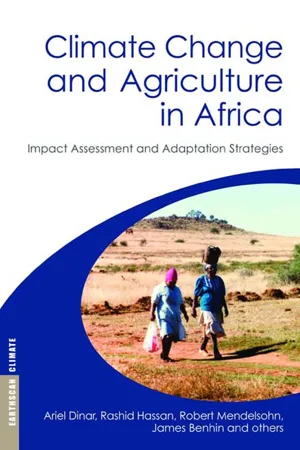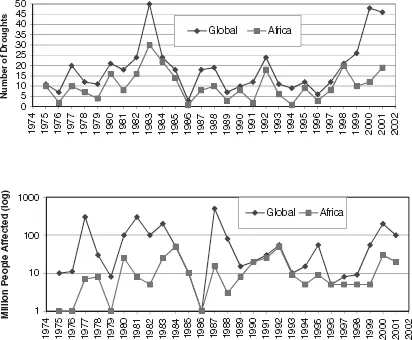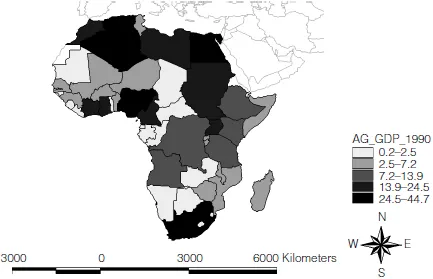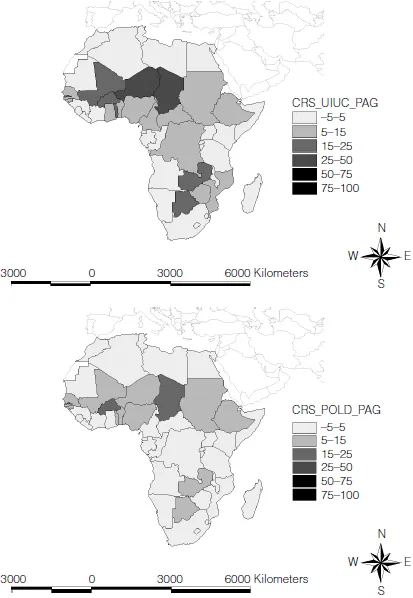![]()
1
Introduction and Rationale
Current evidence (IPCC, 2001, 2007) suggests that countries in temperate and polar locations may enjoy small economic advantages because additional warming will benefit their agricultural sectors. Many countries in tropical and subtropical regions are expected to be more vulnerable to warming because additional warming will affect, among other things, their dwindling water balance and harm their agricultural sectors. The problem is expected to be most harsh in Africa where current climate is already severe, current information is the poorest, technological change has been the slowest and the domestic economies depend most heavily on agriculture. African farmers have adapted to some extent to climate variability, but climate change may well force large regions of marginal agriculture in Africa out of production (Kurukulasuriya et al, 2006).
Even without climate change, there are serious concerns about agriculture in Africa because of water supply and water variability. Figure 1.1 (see also plate 1) provides both the spatial means and the inter-temporal variation of rainfall in the continent. Vast sections of Africa do not have enough water to support crops, and these same areas are highly vulnerable to water variability. Drought events are common in Africa (Figure 1.2). The number of people affected by drought in Africa is nearly equal to the entire world population affected by drought in certain years. Climate change is expected to aggravate these impacts.
A number of countries in Africa already face semi-arid conditions that make agriculture challenging. Further, development efforts have been particularly difficult to sustain. African agriculture has the slowest record of productivity increase in the world. Experts are concerned that the agriculture sector in Africa will be especially sensitive to future climate change and any increase in climate variability. The current climate is already marginal with respect to precipitation in many parts of Africa. Further warming in these semi-arid locations is likely to be devastating to agriculture there. Even in the moist tropics, increased heat is expected to reduce crop yields. Agronomic studies (in this volume) suggest that yields could fall quite dramatically in the absence of costly adaptation measures. The current farming technology is basic, and incomes low, suggesting that farmers will have few options to adapt. Presently, public infrastructure such as roads, irrigation systems, long-term weather forecasts, and agricultural research and extension are inadequate to secure appropriate adaptation. Unfortunately, none of the empirical studies of climate impacts in Africa has explored what adaptations would be efficient for either African farmers or African governments.
Figure 1.1 Africa: Mean annual total precipitation (mm/year) (top) and coefficient of variation (%) (bottom) derived from University of East Anglia Climate Research Unit (UEA-CRU) 1951–2000 monthly time series
Note: See plate 1 for a colour version of this figure.
Source: Lotsch (2006)
Figure 1.2 Number of drought events (top) and population affected by drought (bottom) globally (diamonds) and in Africa (squares) during 1975–2001 (x-axis). People affected are defined as requiring immediate assistance
Source: Based on Office of US Foreign Disaster Assistance/Centre for Research on the Epidemiology of Disasters (OFDA/CRED) International Disaster Database (www.cred.be/emdat)
This is a serious deficiency in African impact research, given the likely importance of efficient adaptation to the continent (Mendelsohn, 2000).
Although there are well-established concerns about climate change effects on agriculture in Africa, there is little quantitative information on how serious these effects will be. Existing studies by the year 2000 covered only a small fraction of Africa and focused on a handful of countries. In addition, few of the African studies included data on and analysis of actual farmer behaviour (i.e. adaptation, which includes responses such as planting dates, harvest dates, use of fertilizer and crop choice). Existing studies have mostly examined how individual crops behave in controlled experiments, addressing largely grain crops (see literature review in Annex 1 and Kurukulasuriya and Rosenthal, 2003). By using results of controlled experiments, researchers could estimate coefficients that measure climate change impact on crop yield that, in association with market prices, could provide experimental-based impact estimates. For a more detailed discussion about crop experiments and their use in estimating impact of climate change on crops, as well as other approaches to estimating impact of climate change on agriculture, see Chapter 3.
A first attempt to evaluate the likely impact of climate change on the agricultural sector in Africa on a continent-wide scale (Mendelsohn et al, 2000) had to rely on studies about climate sensitivity that have been performed in the United States (Mendelsohn et al, 1994, 1996; Mendelsohn and Neumann, 1999). Because local African studies have not yet calibrated climate sensitivity, these initial estimates were highly tentative, but provided a sense of the uncertainty surrounding African forecasts.
We present results that used response functions calibrated from experimental models in the US. Forecasts of agricultural impacts in billions of dollars for the year 2100 for each country using 14 different climate models are presented in terms of percentage of gross domestic product (GDP) (base agricultural GDP year is 1990; Figures 1.3a, b, plates 2 and 3). The experimental response function is more climate sensitive and leads to larger benefits in the polar region and larger damages in the low latitudes compared with the cross sectional results. The figures contain a picture of the average effect across all 14 general circulation models (GCMs), as well as the most optimistic and the most pessimistic results. The most optimistic climate model, Pollard and Thompson – Global Environment and Ecological Simulation of Interactive Systems (GENESIS) with dynamic sea-ice (POLD), predicts a modest increase in temperature near the equator and a larger increase in the temperate zones and near the poles (Thompson and Pollard, 1995). The most pessimistic climate model, University of Illinois at Urbana-Champaign (UIUC), predicts significant warming near the equator and moderate warming near the poles (Schlesinger and Zhao, 1989). These different temperature and precipitation forecasts have important implications for the climate in Africa. However, all the models show that Africa is the most vulnerable continent in the world to climate change.
Figure 1.3a Agricultural GDP of African countries in 1990 (AG_GDP_1990) in billions of 1990 US$
Note: See plate 2 for a colour version.
Source: Mendelsohn et al (2000)
The results in Figure 1.3b suggest the likely continent-wide impact of 6–100 per cent reduction in GDP in 2100, except for two or three countries projected to benefit from climate change. These predictions depend on experimental results from the agronomic literature. We also examined predictions that come from the results of cross sectional comparisons across US farms. The results show a similar response by African agriculture to future climate scenarios, but the effects are much smaller ( Figure 1.3c, plate 4). The results in Figure 1.3c suggest that the impacts are much less severe, ranging between 6 and 60 per cent of GDP in 2100, and that more countries would benefit from climate change.
Figure 1.3b Percentage change in agricultural GDP in 2100 in African countries due to climate change, using the UIUC and POLD global climate change models and experimental (EXP) coefficients. Values on the top and bottom panels are based on the UIUC and POLD model runs, respectively (positive values mean loss and negative values mean gain)
Note: See plate 2 for a colour version.
Source: Mendelsohn et al (2000)
Figure 1.3c Percentage change in agricultural GDP in 2100 in African countries due to climate change, using the UIUC and POLD global climate change models and cross sectional (CRS) coefficients. Values on the top and bottom panels are based on the UIUC and POLD model runs, respectively (positive values mean loss and negative values mean gain)
Note: See plate for a colour version.
Source: Mendelsohn et al (2000)
The results in Figure 1.3c suggest that with cross sectional coefficients (that take into account adaptation), impacts are much less severe, although they range between 6 and 60 per cent of GDP in 2100. However, more countries in this analysis will benefit from climate change.
The overall results (Figures 1.3b and 1.3c) indicate that the climate sensitivity of agriculture in Africa is important. Even relying upon a single climate model, UIUC, the impacts in Africa as a continent can range from a potential loss of $25 billion1 to a loss of $194 billion per year, depending on the climate sensitivity used. The most pessimistic forecast comes from the experimental simulation data that suggest that African countries may lose 47 per cent of their agricultural revenue because of global warming. However, this forecast is possibly extreme because only limited adaptation is included in the model, and the theoretical models in this case do not contain any tropical crops. The cross sectional forecast was less pessimistic, suggesting losses of only 6 per cent of agricultural GDP. These numbers are more moderate because cross sectional models automatically include a comprehensive set of adaptation measures. It is likely that the correct estimates for Africa are bounded by these two US-based estimates. However, even this is uncertain because the US results are calibrated to a temperate climate and US farmers use more capital-intensive agricultural technologies than farmers in Africa.
Nevertheless, these results are sufficiently indicative of how African agriculture may be very vulnerable to climate change. The modelling results presented here indicate that the potential damages may be large both in absolute terms and as a fraction of agricultural GDP. However, even these impact estimates may be optimistic because they were based on US climate response functions. While the predictions presented here may look irrelevant nowadays due to availability of new procedures and data, they were alarming, especially when combined with other problems facing African countries, such as slow technological change, poor information availability, high dependency of the economy on agriculture and lack of appropriate institutions. These problems are severe even without climate change.
A first response to these results was the recognition that Africa needs an immediate and comprehensive analysis of likely climate change impacts and adaptation options.2 The need for analysis was transformed into a series of multi- country research activities conducted under the Global Environment Facility- (GEF-) funded project: ‘Climate, Water and Agriculture: Impacts on and Adaptation of Agro-ecological Systems in Africa’. The main goal of the project was to develop multipliable analytical methods and procedures to assess quantitatively how climate affects current agricultural systems in Africa, predict how these systems may be affected in the future by climate change under various global warming scenarios, and what role could adaptation play. The project has been implemented in 11 countries: Burkina Faso, Cameroon, Ghana, Niger and Senegal in western Africa; Egypt in northern Africa; Ethiopia and Kenya in eastern Africa; and South Africa, Zambia and Zimbabwe in southern Africa. The study countries covered all key agroclimatic zones and farming systems in Africa. This is the first analysis of climate impacts and adaptation in the Africa continent of such scale, and the first in the world to combine cross-country, spatially referenced survey and climatic data for conducting this type of analysis.
This book focuses mainly on the policy implications of the quantitative asses...






